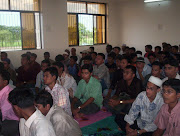AIDS - Bachte hole jaante hobE
Fast facts about HIV
What is HIV?
HIV stands for 'human immunodeficiency virus'. HIV is a virus (of the type called retrovirus) that infects cells of the human immune system (mainly CD4 positive T cells and macrophages—key components of the cellular immune system), and destroys or impairs their function. Infection with this virus results in the progressive deterioration of the immune system, leading to 'immune deficiency'.
The immune system is considered deficient when it can no longer fulfill its role of fighting off infections and diseases. Immunodeficient people are more susceptible to a wide range of infections, most of which are rare among people without immune deficiency. Infections associated with severe immunodeficiency are known as 'opportunistic infections', because they take advantage of a weakened immune system.
What is AIDS?
AIDS stands for 'acquired immunodeficiency syndrome' and is a surveillance definition based on signs, symptoms, infections, and cancers associated with the deficiency of the immune system that stems from infection with HIV.
What are the symptoms of HIV?
Most people infected with HIV do not know that they have become infected, because they do not feel ill immediately after infection. However, some people at the time of seroconversion develop “Acute retroviral syndrome” which is a glandular fever-like illness with fever, rash, joint pains and enlarged lymph nodes.
Seroconversion refers to the development of antibodies to HIV and usually takes place between 1 and 6 weeks after HIV infection has happened. Whether or not HIV infection causes initial symptoms, an HIV-infected person is highly
infectious during this initial period and can transmit the virus to another person. The only way to determine whether HIV is present in a person's body is by testing for HIV antibodies or for HIV itself.
After HIV has caused progressive deterioration of the immune system, increased susceptibility to infections may lead to symptoms. HIV is staged on the basis of certain signs, symptoms, infections, and cancers grouped by the World Health Organization (WHO).
• Primary HIV infection - may be asymptomatic or experienced as Acute retroviral syndrome
• Clinical stage 1 - asymptomatic or generalized swelling of the lymph nodes
• Clinical stage 2 - includes minor weight loss, minor mucocutaneous manifestations, and recurrent upper respiratory tract infections
• Clinical stage 3 - includes unexplained chronic diarrhoea, unexplained persistent fever, oral candidiasis or leukoplakia, severe bacterial infections, pulmonary tuberculosis, and acute necrotizing inflammation in the mouth.Some persons with clinical stage 3 have AIDS.
• Clinical stage 4 - includes 22 opportunistic infections or cancers related to HIV. All persons with clinical stage 4 have AIDS. Most of these conditions are opportunistic infections that can be treated easily in healthy people.
When does a person have AIDS?
AIDS is a surveillance term defined by the United States Centers for Disease Control and Prevention (CDC) and by the European Centre for the Epidemiological Monitoring of AIDS (EuroHIV). The term AIDS applies to the most advanced stages of HIV infection, defined by the occurrence of any of more than 20 opportunistic infections or HIV-related cancers. In addition, the CDC defines AIDS on the basis of a CD4 positive T cell count of less than 200 per mm3 of blood.
How quickly do people infected with HIV develop AIDS?
The length of time can vary widely between individuals. The majority of people infected with HIV, if not treated, develop signs of HIV-related illness within 5-10 years, but the time between infection with HIV and being diagnosed with AIDS can be 10–15 years, sometimes longer. Antiretroviral therapy can slow down disease progression to AIDS by decreasing the infected person’s viral load.
WHO recommends initiation of antiretroviral therapy for all HIV-infected adolescents and adults who are at clinical stage 4 or have a CD4 positive T cell count below 200 per mm3, and for some persons who are at clinical stage .
Where is HIV found?
HIV is found in many body fluids including blood, semen, vaginal fluids and breast milk.
How is HIV transmitted?
HIV is transmitted through:
• Unprotected penetrative (vaginal or anal) and oral sex with an infected person
• Blood transfusion with contaminated blood
• By using contaminated syringes, needles or other sharp instruments
• From an infected mother to her child during pregnancy, childbirth and
breastfeeding
Can I get HIV from casual contact?
HIV is not transmitted by day-to-day contact in social settings, schools or in the
workplace. You cannot be infected by shaking someone's hand, by hugging someone, by using the same toilet or drinking from the same glass as an HIV-positive person, playing sports with or by being exposed to coughing or sneezing by anyone living with HIV. So you should not be fearful of interacting with persons who are living with the disease.
How can you limit your risk of getting HIV through sex?
• Abstain from sex
• Remain faithful in a relationship with an uninfected equally faithful partner with no other risk behaviour
• Practice only non-penetrative sex
• Use male or female condoms correctly each time you have sex
In addition to the above, you can further reduce the risk of HIV infection through sex?
• Delay the age you begin to have sexual relations
• Reduce the number of sexual partners you have
• Get tested and treated for sexually transmitted infections (STIs)
How can you prevent the other ways of HIV transmission?
• Avoid injecting drugs, or if you choose to inject drugs, always use new and disposable needles and syringes
• Ensure that any blood or blood products that you might need are tested for HIV and that blood safety standards are implemented.
What is 'safer' sex?
No sexual act is 100% safe. Safer sex involves taking precautions that decrease the potential of transmitting or acquiring STIs, including HIV, through sex. Using condoms correctly every time one has sex is considered ‘safer’ sex.
How effective are condoms in preventing HIV?
Quality-assured male and female condoms are the only products currently available to protect against STIs, including HIV. When used properly every time one has sex, condoms are a proven and effective means of preventing HIV infection in women and men.
However, apart from abstinence, no protective method is 100% effective, and condom use cannot guarantee absolute protection against any STI. In order to achieve the protective effect of condoms, they must be used correctly all the time. Incorrect use can lead to condom slippage or breakage, thus diminishing their protective effect.
What is a female condom?
The female condom is only female-controlled contraceptive barrier method currently on the market. The female condom is a strong, soft, transparent polyurethane sheath inserted in the vagina before sexual intercourse. It entirely lines the vagina and provides protection against both pregnancy and STIs including HIV, when used correctly at each act of intercourse.
What is the risk of getting HIV from kissing?
Transmission though kissing on the mouth carries virtually no risk; no evidence has been found that the virus is spread through saliva by kissing.
What is the risk of getting HIV through body piercing or from a tattoo?
A risk of HIV transmission exists if non-sterile instruments are used. Instruments that are intended to penetrate the skin should be sterilized and used once, then disposed of or sterilized again.
What is the risk of getting HIV from sharing razors with a person living with HIV?
Any kind of cut using a non-sterile object, such as a razor or knife, can transmit HIV. Sharing razors, knives or other sharp instruments with anyone is not advised, unless they are fully sterilized after each use.
Is it ever completely safe to have sex with a HIV-positive person?
No, there is always a risk of transmission when having sex with a HIV-positive person. The risk can be significantly reduced if condoms are properly used every time one has sex.
Is it safe for two HIV-positive individuals to engage in unprotected sex exclusively with each other?
No, it is not safe for two HIV-positive individuals to have unprotected sex with each other as re-infection with other types of HIV and the transmission of other STIs can occur. Use of condoms always is advised, even when both partners are HIV-positive.
How can mother-to-child transmission be prevented?
Transmission of HIV from an infected mother to her child can occur during pregnancy, during labour or after delivery through breastfeeding. The risk of mother-to-child transmission can be reduced by the following:
• Treatment with antiretroviral drugs
• Caesarian section
• Avoiding breastfeeding, but only when replacement feeding is acceptable,
feasible, affordable, sustainable and safe. If not, exclusive breastfeeding is recommended for the first 6 months.
How can people who inject drugs reduce their risk of contracting HIV?
People who inject drugs are at high risk because they can inject HIV directly into their blood stream. But there are certain steps they can take to reduce this risk:
• Take drugs orally (i.e. change from injecting to non-injecting drug use).
• Do not re-use or use the same needles, syringes, water or drug-preparation equipment with other people.
• Use a new syringe (obtained from a reliable source, e.g. a chemist or a needleexchange programme) to prepare and inject drugs each time.
• When preparing drugs, use sterile water or clean water from a reliable source.
• Use a fresh alcohol swab to clean the skin prior to injection.
How can health-care workers help to prevent transmission in health-care settings?
Health-care workers should follow Universal Precautions which are infection-control guidelines developed to protect health workers and their patients from exposure to diseases spread by blood and certain body fluids.
Universal Precautions include:
• Careful handling and disposal of 'sharps' (items that could cause cuts or puncture wounds, including needles, hypodermic needles, scalpel and other blades, knives, infusion sets, saws, broken glass, and nails)
• Hand-washing with soap and water before and after all procedures;
• Use of protective barriers such as gloves, gowns, aprons, masks and goggles when in direct contact with blood and other body fluids;
• Safe disposal of waste contaminated with blood or body fluids;
• Disinfection of instruments and other contaminated equipment; and
• Proper handling of bedding and clothing stained with blood, diarrhoea or other body fluids.
What should you do if you think you have exposed yourself to HIV?
If you think you've been exposed to HIV, you should get immediately seek help from your local health authority to receive counselling and testing for HIV. You should take precautions to prevent transmitting HIV to others in case you are infected with HIV.
What is PEP?
Antiretroviral drugs can be prescribed within 72 hours of exposure to potentially HIVinfected blood or body fluids to prevent HIV sero conversion. This is called “post4 exposure prophylaxis for HIV infection” (HIV-PEP). However HIV-PEP is not 100% effective, even when started very shortly after exposure, so it is vitally important to try to take every measure to prevent transmission of HIV in the first place.
Does HIV only affect men who have sex with men and people who inject drugs?
No. Anyone who has unprotected sex, uses un-sterilized injecting equipment, or has a transfusion with contaminated blood can become infected with HIV. Infants can be infected with HIV from their mothers during pregnancy, during labour or after delivery through breastfeeding. Worldwide, 90% of HIV cases are the result of sexual transmission, and 60–70% of HIV cases occur among heterosexuals.
Can I tell someone has HIV just by looking at them?
No, you cannot tell if someone has HIV by just looking at them. A person infected with HIV may look healthy and feel good, but they can still pass the virus to you. A blood test is the only way a person can find out if he or she is infected with HIV.
Can I have more than one STI at a time?
Yes, you can have more than one STI at the same time. Each infection requires its own treatment. You cannot become immune to STIs. You can catch the same infection over and over again. Many men and women do not see or feel any early symptoms when they first become infected with an STI, however, they can still infect their sexual partner. Presence STIs can also increase your vulnerability to HIV infection.
When you are on antiretroviral therapy, can you transmit the virus to others?
Antiretroviral therapy for HIV does not prevent an infected person from passing on the virus to others. It can keep viral load down to undetectable levels, but HIV is still present in the body and can be transmitted to others through sexual contact, by sharing injecting equipment, or from mothers to their infants during pregnancy, childbirth or breastfeeding.
Are mosquito bites a risk of infection with HIV?
HIV is not spread by mosquitoes or other biting insects. Even if the virus enters a mosquito or another sucking or biting insect, it cannot reproduce in insects. Since the insect cannot be infected with HIV, it cannot transmit HIV to the next human it feeds on or bites.
Does male circumcision prevent HIV transmission?
Recent studies suggest that male circumcision can reduce the risk of acquiring HIV though sex. However, it is not 100% effective and circumcised men can still become infected. In addition, HIV-positive men who are circumcised can infect their sexual partners. Male circumcision should not replace other known methods of prevention, but be always considered as part of a comprehensive of prevention strategy.
Reference: UNAIDS Program
Infolinks In Text Ads
Subscribe to:
Post Comments (Atom)




.jpg)
.jpg)
.jpg)



.jpg)







.jpg)
.jpg)




.jpg)


.jpg)
.jpg)

.jpg)

.jpg)
No comments:
Post a Comment